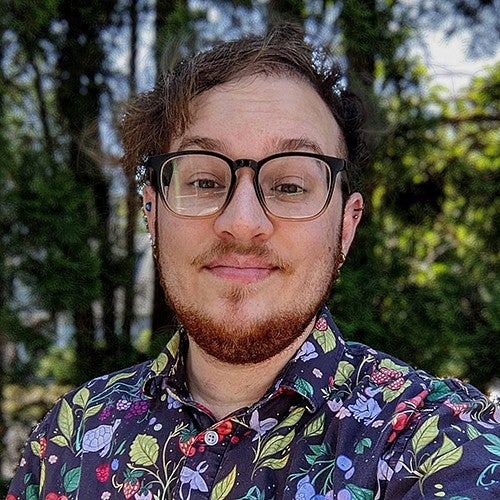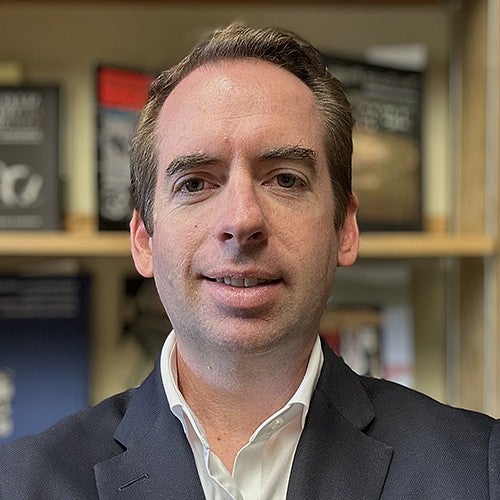Two visiting instructors join CHC's core faculty
A lifelong love of science
Milo Cummings brings a passion for nature and how things work to the classroom.
As a kid, Milo Cummings was usually focused on one of the following: science, zoos or aquariums. And the youngster who grew up in Pleasanton, Calif., also dabbled in art.
“It’s all I was interested in as a kid,” recalls Cummings, who uses they/them pronouns. “I really wanted to know why living things did what they did on the planet. But I also went to art classes and learned a lot about painting.”
Art became their outlet. They found that paper collage was a favorite medium, along with acrylic painting – “Anything super colorful,” they say.
They remember participating in a high school fundraiser, auctioning off portraits of people’s pets. “I knew I wanted to go into biology, so it kind of made sense that I focused on animals,” they say.

Milo Cummings
CHC classes taught this year: 241H Making Food with Microbes; 441H Microbiomes and Society
Hometown: Bay Area, California
Song on Repeat: “Abracadabra” by Lady Gaga
Guilty pleasure: Bulk bin gummy candies from WinCo
What's in the fridge: Greek yogurt and homemade nectarine jam.
Favorite movie: Spirited Away, Howl's Moving Castle, and most other Studio Ghibli movies.
Coffee or tea: Matcha lattes, Earl grey, rose black tea, boba tea... any kind of tea.
Why I chose to teach at the CHC: The small class sizes with passionate students and interdisciplinary interests!
If you take my class, you will: Learn about how microbes are everywhere and can do all sorts of neat things.
I'm a stickler for: Keeping an open mind and remaining as non-judgmental as possible.
Today, Cummings is starting their teaching career at the Clark Honors College as a visiting instructor. They earned their undergraduate degree in biochemistry and cellular biology from the University of California-San Diego. Right after, they continued at San Diego, earning a master’s in biology.
Then they pursued their PhD in microbiology at Oregon State University, developing an interest and a research focus on how microbes survive around methane seeps, deep-sea vents on the ocean floor. “The fact that there was life in such inhabitable places is fascinating,” they say of their research. “I was able to work on the ocean with people who had the same interests.”
They also spent time working with fish biologists and indigenous groups with the Columbia River Inter-Tribal Fish Commission, a quasi-government agency that helps manage treaties with Native populations along the river, spearheads conservation efforts and restoration of habitat for salmon.
At the Clark Honors College, Cummings is looking forward to getting to know students and having concentrated time developing relationships with the community. “The class sizes are small, people really want to be here for the focus, and the environment allows you to follow your heart on things that interest you,” they say.
They are eager to dive in with their first class – Making Food with Microbes. “I believe that everything does start from the student,” they say. “It’s important for the teacher to understand their students as people. I am looking forward to getting to know them and understanding where they are coming from.”
Researching time and space in Japan
For John Leisure, there’s more to Asia than just the events of today.
When John Leisure travels to Japan each year, he’s on a mission as a historian. He wants to understand urban space. With each visit he travels to cities like Tokyo, Osaka, and Kanazawa. He wants to learn about the culture, and he seeks to understand the ramifications of postwar reconstruction.
But equally, he wants to know about the spaces people use, and how they live within and around the structures that make up Japan.
“Over the course of my research, I try to connect with Japanese architects and others who do research,” he says. “I’m interested in the history of space. Flipping through the past is a way to understand what motivated people to make the choices they did. How did cities rebuild when something happened to them, like all the rehousing that took place after World War II? The ideas are foundational to how people live today.”

John Leisure
CHC classes taught in this year: HC 231H – History of Japan; HC 434H/431H - Asia Urbanism: Japan, China, and Korea in the 20th Century
Hometown: Irvine, California
Song on repeat: “Carson City Stage” by Chet Baker and Carson Smith
Guilty pleasure: Kouign-amann from Provisions.
What's in the fridge: Strawberry kefir.
Favorite movie: Tokyo Ga
Coffee or tea: Coffee. Double espresso.
Why you chose to teach at the CHC: The small discussion-based class format. And because of the amazing students and colleagues at the University of Oregon.
If you take my class, you will: Engage with historical-analytical knowledge frameworks and produce interpretations using contextual keywords while learning about Japan and the Asia-Pacific.
I’m a stickler for: Timely submissions.
Leisure joins the Clark Honors College as a seasoned educator of history. In the fall, he will teach HC 434H - Asia Urbanism: Japan, China, and Korea in the 20th Century, a course that focuses on how major cities developed at the time, and HC 231H – History of Japan.
He says his interest in Asia was sparked when he read a book called The Tale of Genji, an account of life in 10th Century Japan. “It opened my eyes to Japan,” he recalls. “It was very profound and inspiring. It carried forward for me and it was a formative experience.”
He graduated from USC with degrees in history and political science. Later, he earned a master’s in regional studies of East Asia from Columbia University. He received his PhD in history from UCLA.
In the classroom, he likes to engage students in a discussion around how people produce history. Giving them room to explore their ideas is part of the learning process when approaching things like urban sprawl, the environment, and how communities see themselves.
“I really enjoy seeing students take it all in,” he says. “It’s fascinating to see what people imagined cities could look like and to think about how the future was created. There are thousands of skyscrapers in present day Tokyo. A hundred years ago most people lived in one and two-story wooden residences. Today, trains operate at eight stories below ground. How do you imagine that? I want the students to put themselves there. To think about the present as a palimpsest of the past.”
